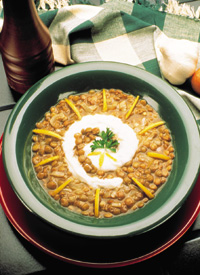
We are becoming more familiar with the great variety of beans through various ethnic cuisines, including Hispanic, Asian, Mediterranean, Italian and Indian.
Furthermore, with the vegetarian movement both in the U.S. and abroad, more legume-based dishes are showing up on restaurant menus and store shelves. A recent USDA study revealed a 28% increase in bean consumption this past year.
Legumes add flavor, color, texture and nutrition to soup. Legume-based soups are generally high in fiber and protein and low in fat. Most dried legumes have a high iron and folic acid content.
Legume-based instant
soup mixes and instant soup cups provide a quick and convenient
way for consumers to enjoy a steaming bowl of soup.
Dried Legumes
Many bean, pea and lentil soups are sold as a dry mix. The U.S. is a leader in dry bean production.Although there are thousands of varieties of legumes in the world, the U.S. only grows about 15 varieties, says Janelle Sterner, director of culinary services, Inland Empire Foods, a California bean supplier. India, for example, uses over 1000 varieties of legumes in its cuisine.
Growing and processing conditions effect the quality of the beans. After harvesting and sorting, the beans are cleaned, steam-cooked and dried in an atmospheric oven. Steam is used to preserve flavor, color and nutrition, says Sterner. During processing, up to 15% of the solids are lost in the cooking water.
Instantized beans can be dried by infrared, dehydration, freeze-drying or drum-drying. Dehydrated beans are less expensive than freeze-dried or drum-dried beans. They are the best choice for functionality, flavor and texture in most applications, notes Sterner.
Proper harvesting and storage at the right temperature are keys to ensuring the quality of the beans. When choosing raw beans, the moisture should be between 10-15% and the color should be light and uniform, reports Sterner. Water and heat damage tends to darken or discolor beans. Raw beans tend to darken with age as well. Because age effects cook quality, Sterner recommends buying the current crop year to ensure freshness.
Deciding which beans and bean ingredients to use in a soup application involves several key considerations:
- Selection. Formulators should have a final product in mind when selecting the type of bean for a particular application. There are many varieties to choose from that sound and look more exotic than the more commonly used varieties. For example, Red Chief is a type of red lentil.
- Performance requirements. Preparation method or instructions, rehydration time, further processing or holding time must be considered.
- Most instant soup cups rehydrate in five to eight minutes after adding boiling water. "Everyone wants a bean that rehydrates quickly," says Sterner. "We can customize the rehydration rate for any bean variety by adjusting our processing parameters. The fastest hydrating whole beans--black, pinto and red--rehydrate with either a five-minute steep or a three-minute simmer."
- Target appearance. Determining the appearance and integrity of the finished product is the key to choosing legume ingredients.
- Legume ingredients are typically available in whole, pieces, flakes or flours. Defining parameters, such as firmness of the bean, whole bean versus bean pieces or broth soup base versus a creamy soup base, help determine the appropriate bean ingredients.
- Using slightly crushed beans provides a "homemade" look and broken pieces deliver more of a creamier background. A flaked product may be used to provide thickness and to dissolve into the stock.
- Performance limiting or enhancing ingredients. Formulators need to consider other ingredients that effect water absorption, such as rice, pasta, seasoning, dehydrated vegetables, starches and thickening agents. For example, a whole bean that simmers with rice will retain its integrity better than a whole bean simmering alone in liquid. A whole bean designed to rehydrate in 20 minutes after simmering in water will not soften as quickly in the presence of starches or thickening agents. A bean with a quicker rehydration rate should be selected, based on the addition of the thickening agent.

In order to avoid problems with hygroscopic ingredients, such as spices and salt, suppliers can incorporate them into a bean flake. This helps to ease rehydration for the consumer.
Legume powders are label-friendly ingredients, which can be used as thickeners, flavor and aroma enhancers, and texture and color enhancers in soups. The powders can be derived from peas, beans or lentils. Some modified starches can be replaced with legume powders.
Formulators can choose from pre-gelatinized powders for instant soups, precooked powders for simmer soups, and legume flours for soups requiring longer cooking times.
The powders are dried with minimal heat that is just enough to gelatinize the starches, according to Edward Schmidt, president, Fiberich Legume Technologies, a Minnesota-based legume powder supplier. Hydrated instantized powders flow readily from a can or when pumped.
Pre-gelatinized powders
absorb twice as much water as conventionally processed peas, beans
and lentils, helping to compensate for the cost of the powders.

Bountiful Beans
Formulators can choose from cranberry beans, navy beans, pintos, kidney bean, Great Northern, green split pea, and other more exotic-sounding beans, such as adzuki, black turtle, cannellini, kunde, Red Chief lentils and yellow peas.Kunde is an African variety that means bean" in Swahili. It is a type of cowpea, a relative of the black-eyed pea, which tastes similar but milder than black-eyed peas. These small cream-colored beans are dark red on and around the eye, and are about the same size as mung or adzuki beans.
While Sterner's company recently added kunde to its offerings, African food has not emerged onto the popular food front. "For companies that want to add something different or are looking to revitalize their product lines, they might want to try kunde in soups," says Sterner.
Her company has been working diligently to grow this African bean variety because it believes it will gain popularity. "It takes five years to take a bean from conception to commercialization; part of our job is to look down the road to see what will be of interest in the future," notes Sterner.
Some simmer soup mixes
on the market feature many bean varieties. For example, Goya Foods
Inc., Secaucus, N.J., markets a 16 Bean Soup Mix and Bean Cuisine
Soup from Reily Foods Company, New Orleans, makes a "13 Bean Bouillabaisse."
Muchos Frijoles
While traditional soups--chicken noodle, tomato, split pea, etc.-- are popular in this country, new soup varieties with ethnic overtones are also emerging.For example, Bean Cuisine from Reily Foods offers several varieties of simmer soup mixes, including Ultima Pasta E Fagioli, Thick As Fog Split Pea, White Bean Provencal and Rocky Mountain Red Bean. The mixes contain separate bean and spice packets "to preserve flavor and freshness."
Black bean, a traditional Hispanic soup, has surfaced in several retail brands. Bean Cuisine's Island Black Bean Soup contains beans, herbs and spices, such as mustard, oregano and cumin. Consumers add their own fresh vegetables and meat.
Goya Foods manufactures a canned Black Bean Soup which contains vinegar, dehydrated onion, bell peppers and garlic. Goya's dried Meal-in-a-Cup version contains similar ingredients and rehydrates in eight minutes after adding boiling water. Fantastic Foods, Petaluma, Calif., offers Jumpin' Black Bean, an instant soup cup containing dehydrated tomatoes, garlic, red and green bell peppers and jalapeno peppers. It rehydrates in five minutes.
Aliza Green, author of The Bean Bible Cookbook, published last year, admits it can be difficult to translate home-style soups into dry mixes or canned soups. She developed various legume-based soups for her cookbook and has also developed commercial soup formulations for clients.
While many of her bean soup recipes are authentic, Green adds her own twist to several of the soup recipes, such as Cuban Black Bean Soup with Sofrito and Smoked Turkey. This is a healthier version of the traditional recipe with ham hocks.
For a standard tomato soup, Green adds Great Northern beans, olive oil, onion, garlic, white pepper and thyme and garnishes it with sharp cheddar cheese. "Garnishing soups is important from a presentation standpoint and for textural contrast," says Green.
Green adds pestos at the end of cooking for several of her soups, such as the Spanish chickpea soup with garlic-mint pesto.
What is the secret
to a successful bean soup? "The freshness of the dried beans is
one of the keys to a great-tasting soup," says Green. Beans over
two-years-old deteriorate in flavor and texture and take longer
to cook. PF

SIDEBAR - Convenient Soup and Meal Cups with a Latin Flair
Last fall, Goya Foods Inc., Secaucus, N.J., introduced a new line of instant soups and beans/rice blends, called Meals-in-a-Cup. Seven varieties include chicken noodle, green split pea, lentil, black bean and navy bean soups as well as black beans and rice and red beans and rice. The dry products are packaged in paperboard cups, which consumers add boiling water. The products are ready-to-eat in six to eight minutes."This new line was developed to provide our consumers with convenient products that are tasty and filling with the hearty flavor of home-cooking," says Ralph Riera, Goya Foods' national marketing manager of rice and beans.
"We have added special blends of spices and ingredients to these meals for an authentic Latin taste," he adds. For example, the company adds the traditional Spanish sofrito--an aromatic blend of vegetables (tomatoes, green peppers, onions, and garlic) cooked in olive oil--to many of its offerings.
"The main challenge in developing soup cups with dried ingredients is getting the quality we want," says Riera. "By using air-dried beans and high-quality spices, we can achieve the flavor and texture profiles we are looking for."
Besides instant soup cups, Goya offers Black Bean Soup (Sopa de Frijol Negro) in a 15-ounce can. This Latin-style soup is popular because it is more like seasoned stew or guisadas, says Riera.